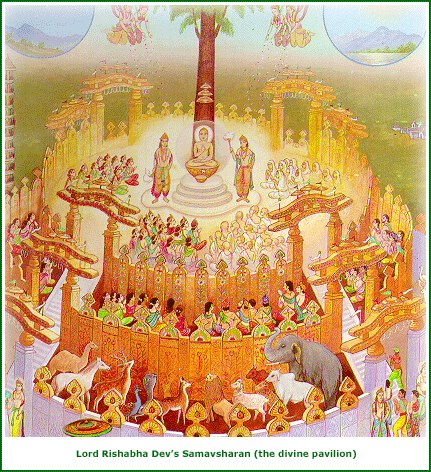
Month: May 2014

Our country got his name from King Bharata, son of Rishabha.
This is different from Mahabharata’s Bharata (we will also discuss them, if possible in chronological order)…the major aspects.
Here’s post about Rishabha:
Rishabha, also known as Adinatha (The first protector), Adishvara and Adeshvara (Primal Lord), is the traditional founder of Jainism.He was the first of the twenty-four tīrthaṅkara. According to the legends, he belonged to the Ikshvaku dynasty of ancient Ayodhya.Rishabha is also known as Rikhava and is sometimes called Rishabha of Kosala.
In the Veda, he finds references specifically in the Rigveda and the Taitriya Aryanyaka. Various vedic sages paid reverence to Rishabha and called him “Lord of Lords”. He is mentioned as Kesi, the head of Vatrasana Shramana in the Rigveda, which is further elaborated in the Bhagavata Purana (c. 8th century CE). There is a metaphorical reference to Rishabha in the Vratyakhanda of Arthaveda.However, these mention of Rishabha in Veda have multiple interpretations. There is no conclusive evidence of him being the founder of Jainism in the vedic literature. He was, however worshiped as the first Tirthankara and the founder of Jainism from the 4th or 3rd century BCE.
Legend:
Rishabha was born to Nabhi Raja and Marudevi at Ayodhya before the human civilization was much developed. People were primitive and illiterate and he taught them agriculture, tending of animals, cooking, poetry, painting, sculpture and similar arts. He introduced karma-bhumi (the age of action). The institution of marriage, ceremony of cremating the dead and festivals in honour of gods like Indra and Naga came into existence. He introduced a total of seventy-two sciences which includes arithmetic, plastic and visual arts, the art of lovemaking, singing and dancing. He taught people how to extract sugarcane juice. The name Ikshvaku dynasti came from the word Ikhsu (sugarcane) due to this event. His kingdom was kind and gentle and he is credited for transforming a tribal society into an orderly one. Like any Tirthankar & other legendary figures of Indian history (who were great warriors), he too was a great warrior with great strength and body. However its was never needed by him to show his warrior aspect.Rishabha is known for advocating non-violence. He was one of the greatest initiator of human progress.
Rishabha had two wives. One of them was Sunanda and the other is given different names, Yasaswati, Nanda and Sumangala, in different texts. He had one hundred sons and two daughters. Among these, Sunanda was the mother of Bahubali and Sundari whereas Sumangala was the mother of Bharat and Brahmi. Bharata, Rishabha’s eldest son, was a Chakravartin who later attained moksha and hence is worshipped as a siddha by the Jains. India was named ‘Bhāratavarsha’ or Bhārata after him.
Rishabha gave his kingdom to his two sons Bharata and Bahubali. Bharata received the northern half of his kingdom with Ayodhya as the capital whereas Bahubali received the southern half with the city Podanapur.
He attained liberation on Mount Kailasa at the age of 84 lakh purva(5,92,70,40,00,00,00,000;where 1 purva equals to 84*8400000) . His preachings were recorded into fourteen scriptures known as Purva.

After nearly 1200 years , Hindus reclaim , what was always their’s.
India will lead the world once more. We will be spring of knowledge , science, spirituality and morality.

“Praritranaya Sadhunam,
Vinashaya Cha Dushkritam, Dharamasansthapnaya
Sambhavami Yuge-Yuge.”-
Aaj Ke Baad Modi Sarkaar! Lord Krishna bless us

Valley of Flowers in Uttarakhand-India !!!

Those were the days of British Raj !!!

The Ring taken off the finger of the dead ruler-Tippu Sultan by the Duke of Wellington, Arthur Wellesley, as his personal spoil of war after the Battle of Seringapatam in 1799.
The ring then found its way into the hands of another military family, that of FitzRoy Somerset, the 1st Baron Raglan. A famous soldier of the early 19th century, he joined Duke Wellington’s service in 1808 and rose to become his right-hand man for the next 40 years. He fought in major campaigns under Duke Wellington, including Waterloo and in the Crimea.
FitzRoy Somerset married the Duke’s favourite niece Emily Wellesley- Pole who was in possession of the ring, a gift from her uncle.
The ring has been valued at £10,000 to £15,000 and is part of the private collection of Fitzroy John Somerset, the great great grandson of the 1st Baron Raglan. The collection contains items that have been the possession of the family from 1858, including historical medals, arms and armour, militaria, pictures, furniture, silver, books, Indian weapons and works of art, as well as a selection of art.
During initial years Tippu Sultan was a religious fanatic who inflicted/encouraged death blow on Hindus and Christians with massive conversions-destruction of temples/churches in Kerala,Coorg and Mangalore region by violent means had to compromise politically with local Mysore Hindu population to fight against British.
This is not attributed as a true secularism but a shrewd politics. Some so called Left wing Liberal historians hide real facts and highlight Tippu as a patriotic and secular champion.

The Ram – Sita gold coin of Akbar. Minted in 1585

Sukhdev was borned on 15th May 1907. He gave his life at very young age , for his Motherland.
We salute him.
_/_

If Dara Shikhoh, the eldest son and heir apparent of Shah Jahan, had been emperor, history of Islam in India would be different !!!
Agree?